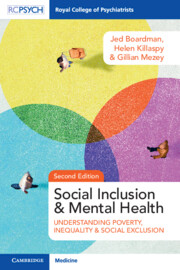Book contents
- Social Inclusion and Mental Health
- Reviews
- Social Inclusion and Mental Health
- Copyright page
- Contents
- Foreword to Second Edition
- Foreword to First Edition (2010)
- Preface
- Acknowledgements
- Chapter 1 Introduction: Poor, Excluded, and Unequal
- Section 1 Social Exclusion, Poverty, and Inequality
- Section 2 Participation of People with Mental Health Conditions
- Section 3 Including People
- Index
- References
Chapter 1 - Introduction: Poor, Excluded, and Unequal
Published online by Cambridge University Press: 24 November 2022
- Social Inclusion and Mental Health
- Reviews
- Social Inclusion and Mental Health
- Copyright page
- Contents
- Foreword to Second Edition
- Foreword to First Edition (2010)
- Preface
- Acknowledgements
- Chapter 1 Introduction: Poor, Excluded, and Unequal
- Section 1 Social Exclusion, Poverty, and Inequality
- Section 2 Participation of People with Mental Health Conditions
- Section 3 Including People
- Index
- References
Summary
This introductory chapter outlines the structure of the book and some of the themes that appear throughout the book. The themes include intersectionality, the role of social factors in causing and maintaining mental ill-health, the need for a public mental health approach, and the role of mental health professionals and services in facilitating social inclusion. We discuss why social exclusion violates social justice and social solidarity, and put forward ten reasons why mental health professionals should be concerned with social exclusion.
Keywords
- Type
- Chapter
- Information
- Social Inclusion and Mental HealthUnderstanding Poverty, Inequality and Social Exclusion, pp. 1 - 20Publisher: Cambridge University PressPrint publication year: 2022

